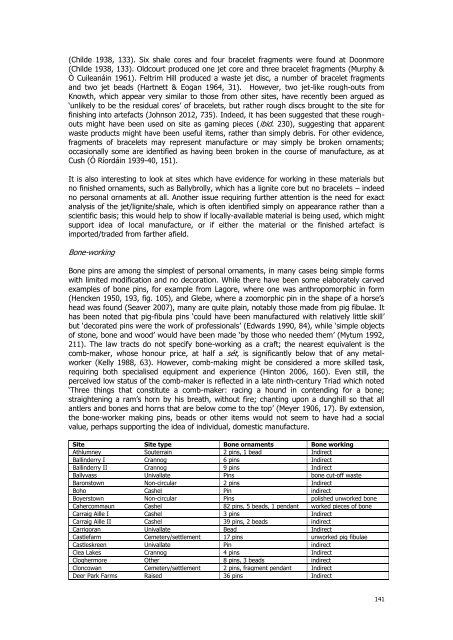EMAP_2012_Report_6_1.pdf (7.3 MB) - The Heritage Council
EMAP_2012_Report_6_1.pdf (7.3 MB) - The Heritage Council
EMAP_2012_Report_6_1.pdf (7.3 MB) - The Heritage Council
Create successful ePaper yourself
Turn your PDF publications into a flip-book with our unique Google optimized e-Paper software.
(Childe 1938, 133). Six shale cores and four bracelet fragments were found at Doonmore<br />
(Childe 1938, 133). Oldcourt produced one jet core and three bracelet fragments (Murphy &<br />
Ó Cuileanáin 1961). Feltrim Hill produced a waste jet disc, a number of bracelet fragments<br />
and two jet beads (Hartnett & Eogan 1964, 31). However, two jet-like rough-outs from<br />
Knowth, which appear very similar to those from other sites, have recently been argued as<br />
‘unlikely to be the residual cores’ of bracelets, but rather rough discs brought to the site for<br />
finishing into artefacts (Johnson <strong>2012</strong>, 735). Indeed, it has been suggested that these roughouts<br />
might have been used on site as gaming pieces (ibid. 230), suggesting that apparent<br />
waste products might have been useful items, rather than simply debris. For other evidence,<br />
fragments of bracelets may represent manufacture or may simply be broken ornaments;<br />
occasionally some are identified as having been broken in the course of manufacture, as at<br />
Cush (Ó Ríordáin 1939-40, 151).<br />
It is also interesting to look at sites which have evidence for working in these materials but<br />
no finished ornaments, such as Ballybrolly, which has a lignite core but no bracelets – indeed<br />
no personal ornaments at all. Another issue requiring further attention is the need for exact<br />
analysis of the jet/lignite/shale, which is often identified simply on appearance rather than a<br />
scientific basis; this would help to show if locally-available material is being used, which might<br />
support idea of local manufacture, or if either the material or the finished artefact is<br />
imported/traded from farther afield.<br />
Bone-working<br />
Bone pins are among the simplest of personal ornaments, in many cases being simple forms<br />
with limited modification and no decoration. While there have been some elaborately carved<br />
examples of bone pins, for example from Lagore, where one was anthropomorphic in form<br />
(Hencken 1950, 193, fig. 105), and Glebe, where a zoomorphic pin in the shape of a horse’s<br />
head was found (Seaver 2007), many are quite plain, notably those made from pig fibulae. It<br />
has been noted that pig-fibula pins ‘could have been manufactured with relatively little skill’<br />
but ‘decorated pins were the work of professionals’ (Edwards 1990, 84), while ‘simple objects<br />
of stone, bone and wood’ would have been made ‘by those who needed them’ (Mytum 1992,<br />
211). <strong>The</strong> law tracts do not specify bone-working as a craft; the nearest equivalent is the<br />
comb-maker, whose honour price, at half a sét, is significantly below that of any metalworker<br />
(Kelly 1988, 63). However, comb-making might be considered a more skilled task,<br />
requiring both specialised equipment and experience (Hinton 2006, 160). Even still, the<br />
perceived low status of the comb-maker is reflected in a late ninth-century Triad which noted<br />
‘Three things that constitute a comb-maker: racing a hound in contending for a bone;<br />
straightening a ram’s horn by his breath, without fire; chanting upon a dunghill so that all<br />
antlers and bones and horns that are below come to the top’ (Meyer 1906, 17). By extension,<br />
the bone-worker making pins, beads or other items would not seem to have had a social<br />
value, perhaps supporting the idea of individual, domestic manufacture.<br />
Site Site type Bone ornaments Bone working<br />
Athlumney Souterrain 2 pins, 1 bead Indirect<br />
Ballinderry I Crannog 6 pins Indirect<br />
Ballinderry II Crannog 9 pins Indirect<br />
Ballyvass Univallate Pins bone cut-off waste<br />
Baronstown Non-circular 2 pins Indirect<br />
Boho Cashel Pin indirect<br />
Boyerstown Non-circular Pins polished unworked bone<br />
Cahercommaun Cashel 82 pins, 5 beads, 1 pendant worked pieces of bone<br />
Carraig Aille I Cashel 3 pins Indirect<br />
Carraig Aille II Cashel 39 pins, 2 beads indirect<br />
Carrigoran Univallate Bead Indirect<br />
Castlefarm Cemetery/settlement 17 pins unworked pig fibulae<br />
Castleskreen Univallate Pin indirect<br />
Clea Lakes Crannog 4 pins Indirect<br />
Cloghermore Other 8 pins, 3 beads indirect<br />
Cloncowan Cemetery/settlement 2 pins, fragment pendant Indirect<br />
Deer Park Farms Raised 36 pins Indirect<br />
141
















